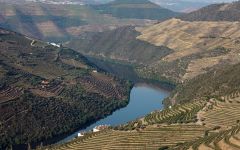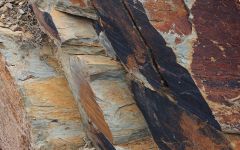Quinta da Romaneira Douro 2009
-
Wine &
Spirits -
Wine
Enthusiast -
Robert
Parker -
Wine
Spectator


Product Details
Your Rating
Somm Note
Winemaker Notes
Professional Ratings
-
Wine & Spirits
Christian Seeley and Antonio Agrellos of Quinta do Noval (see above) are also involved in a rather ornate wine and hospitality project just upriver at Romaneira. While the ambitious hotel closed after the economic crash and has yet to reopen, the vineyard and winery are putting out some astonishing wines. Agrellos blended this 2009 from tourigas nacional and franca, with a little roriz and tinto cao. I could just say it smells great and stop there. But I’d be leaving out the sense of quiet elegance that layers the wine in perfectly ripe cherry flavor and a cushion of tannins. It seems to create an architectural space in the mouth, framing the steep Douro canyon into a lasting flavor.
-
Wine Enthusiast
From a great year in the Douro, this is a complex, impressive wine. It has elegance rather than brute power, pushed forward by smooth yet dry tannins and ripe black fruits. A touch of spice, balanced acidity and a great potential for aging. Cellar Selection.
-
Robert Parker's Wine Advocate
The 2009 Tinto, the estate wine just labeled as “Quinta da Romaneira,” was aged for 14 months in second year French barriques. It is a 60/30 blend of Touriga Nacional and Touriga Franca, with equal portions of Tinta Roriz and Tinto Cão filling out the blend. I've tracked this periodically over the years. It has never turned into anything particularly dramatic, but it has consistently improved and integrated parts to a point where it is a complete pleasure to drink, smooth and flavorful. While my early projections in terms of score were pretty much where I want them to be, it is still worth noting how delicious this is at the moment and how graceful. In this big, big vintage, this is curiously restrained. That makes it actually drinkable. It still has the wherewithal to tighten a bit with air.
-
Wine Spectator
Big, ripe and juicy, offering luscious flavors of dark cherry and red plum, with hints of paprika and light smoke. Features medium-grained tannins and juicy acidity. The finish lengthens out with spicy and toasty notes. Touriga Nacional, Touriga Franca and Tinta Cao.
Other Vintages
2015-
Wine
Enthusiast -
Jeb
Dunnuck -
Wine
Spectator
-
Wine
Enthusiast -
Wine
Spectator -
James
Suckling





Romaneira is one of the great historic Quintas of the Douro Valley in Northern Portugal, on a spectacularly beautiful site overlooking the Douro river facing south, its rocky soil lending its particular character to the wines.
Recently a new and exciting chapter has been added to Romaneira's long and illustrious story, with the emergence of Romaneira as a key player in the "Douro Revolution": the discovery that our ancient local grape varieties can be used to make not only excellent Port wines, but increasingly also outstanding unfortified wines that are finding their place among the great wines of the world, while being an expression of our unique terroir.

With hundreds of red grape varieties to choose from, winemakers have the freedom to create a virtually endless assortment of blended red wines. In many European regions, strict laws are in place determining the set of varieties that may be used, but in the New World, experimentation is permitted and encouraged resulting in a wide variety of red wine styles. Blending can be utilized to enhance balance or create complexity, lending different layers of flavors and aromas. For example, a red wine blend variety that creates a fruity and full-bodied wine would do well combined with one that is naturally high in acidity and tannins. Sometimes small amounts of a particular variety are added to boost color or aromatics. Blending can take place before or after fermentation, with the latter, more popular option giving more control to the winemaker over the final qualities of the wine.
How to Serve Red Wine
A common piece of advice is to serve red wine at “room temperature,” but this suggestion is imprecise. After all, room temperature in January is likely to be quite different than in August, even considering the possible effect of central heating and air conditioning systems. The proper temperature to aim for is 55° F to 60° F for lighter-bodied reds and 60° F to 65° F for fuller-bodied wines.
How Long Does Red Wine Last?
Once opened and re-corked, a bottle stored in a cool, dark environment (like your fridge) will stay fresh and nicely drinkable for a day or two. There are products available that can extend that period by a couple of days. As for unopened bottles, optimal storage means keeping them on their sides in a moderately humid environment at about 57° F. Red wines stored in this manner will stay good – and possibly improve – for anywhere from one year to multiple decades. Assessing how long to hold on to a bottle is a complicated science. If you are planning long-term storage of your reds, seek the advice of a wine professional.

The home of Port—perhaps the most internationally acclaimed beverage—the Douro region of Portugal is one of the world’s oldest delimited wine regions, established in 1756. The vineyards of the Douro, set on the slopes surrounding the Douro River (known as the Duero in Spain), are incredibly steep, necessitating the use of terracing and thus, manual vineyard management as well as harvesting. The Douro's best sites, rare outcroppings of Cambrian schist, are reserved for vineyards that yield high quality Port.
While more than 100 indigenous varieties are approved for wine production in the Douro, there are five primary grapes that make up most Port and the region's excellent, though less known, red table wines. Touriga Nacional is the finest of these, prized for its deep color, tannins and floral aromatics. Tinta Roriz (Spain's Tempranillo) adds bright acidity and red fruit flavors. Touriga Franca shows great persistence of fruit and Tinta Barroca helps round out the blend with its supple texture. Tinta Cão, a fine but low-yielding variety, is now rarely planted but still highly valued for its ability to produce excellent, complex wines.
White wines, generally crisp, mineral-driven blends of Arinto, Viosinho, Gouveio, Malvasia Fina and an assortment of other rare but local varieties, are produced in small quantities but worth noting.
With hot summers and cool, wet winters, the Duoro has a maritime climate.
